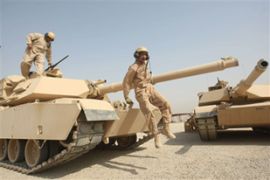US troops in Iraq fall below 50,000
Symbolic milestone as withdrawal continues on schedule, but insecurity, uncertainty remain.

Odierno, too, will leave Iraq shortly: He will turn over command to his successor, General Lloyd Austin, on September 1.
Second US milestone
Odierno’s “goal” was established by Obama in February 2009, when he announced in a speech that the US would withdraw all combat troops from Iraq by the end of August 2010.
It is the second of three major milestones on the road to an (almost) complete US withdrawal. The first came in June of last year, when US forces withdrew from Iraqi cities and towns; the last will come in December 2011, when the US is required to end its occupation of Iraq.
Both of those milestones were established by the status-of-forces agreement, a document negotiated in 2008 by the US and Iraqi governments.

The US invaded Iraq in 2003 with roughly 150,000 troops, and the Pentagon confidently predicted they would not stay long: Pre-war plans called for a force of less than 50,000 by the end of 2003.
But “combat operations” – which former US president George Bush declared over in May 2003 – would continue for another seven years. The US presence in Iraq hit a low of around 115,000 troops in 2004, and then started an uphill climb, maxing out at around 171,000 in 2007 – the height of the so-called “surge”.
Troop levels have declined steadily since then, with the largest drops coming since Obama took office.
‘Wrong time’ for withdrawal
The end of “combat operations” has been welcomed in Iraq, but the diminishing US presence is also creating some unease.
A poll conducted by Iraq’s Asharq Research Centre found that 60 per cent of Iraqis believe this is the “wrong time” for a major US drawdown. More than half of respondents said the withdrawal would have a negative effect on the country.
Asked whether Obama “cared about the situation in Iraq,” 42 per cent said no.
The withdrawing US troops leave behind a still-insecure Iraq, where bombings and assassinations kill an average of 300 people each month. July was the deadliest month in more than two years, with at least 535 people killed, according to Iraqi government figures.
Odierno said in a CBS television interview on Sunday that a “complete failure” by Iraqi security forces could force the US to resume combat operations. And John Brennan, a White House homeland security adviser, said on Tuesday that there would be an “ongoing effort” to strengthen the Iraqi army and police forces.
“We recognise that there’s still more progress that needs to be made inside of Iraq to ensure that security is going to prevail throughout the country,” he said.
Politics, too, remain deadlocked more than five months after a parliamentary election. The heads of the two largest coalitions – Iyad Allawi, who runs the Iraqiya bloc, and Nouri al-Maliki, who heads State of Law – have both failed to form coalitions.
The Asharq poll reflected that split. No clear majority agreed on who would likely become the next prime minister: 33 per cent chose Allawi; 31 per cent chose al-Maliki; 10 per cent picked Adil Abd al-Mahdi, the head of the Supreme Islamic Council of Iraq; and the remaining votes were sprinkled across no less than 14 other candidates.